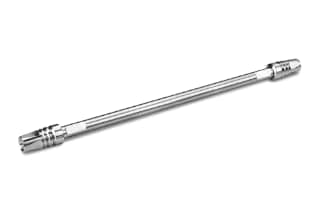
|
Chemistry |
C18 |
|
Separation Mode |
Reversed Phase |
|
Particle Substrate |
Silica |
|
pH Range Min |
2 pH |
|
pH Range Max |
8 pH |
|
Temperature Limits |
45 C |
|
Maximum Pressure |
18000 psi (1240 Bar) |
|
Endcapped |
Yes |
|
Bonding Technology |
T3 |
|
Silanol Activity |
Medium |
|
Particle Shape |
Spherical |
|
Particle Size |
1.8 µm |
|
Endfitting Type |
Parker-style |
|
Pore Size |
100 Å |
|
Format |
Column |
|
Surface Area |
230 |
|
System |
UPLC, UHPLC |
|
Particle Technology |
HSS |
|
USP Classification |
L1 |
|
Inner Diameter |
2.1 mm |
|
Length |
150 mm |
|
Carbon Load |
11 % |
|
eCord |
Yes |
|
UNSPSC |
41115709 |
|
Brand |
ACQUITY UPLC |
|
Product Type |
Columns |
|
Units per Package |
3 pk |

ACQUITY UPLC HSS T3 Column, 100Å, 1.8 µm, 2.1 mm X 150 mm, 3/pk
As the new industry standard for retention and separation of polar compounds with reversed-phase HPLC AND UPLC Technology, ACQUITY UPLC HSS T3 Columns are silica-based columns that provide superior performance across a wide pH range. These columns are certified for use in UPLC separations and are designed to provide long column lifetimes at low pH while improving peak shape for amine-containing bases at pH 7. This is made possible in part by Waters’ advanced T3 bonding process, utilizing a trifunctional C18 alkyl phase that is bonded at a ligand density which promotes polar compound retention and aqueous mobile phase compatibility. By combining unique bonding and end-capping processes, these columns offer enhanced performance, lifetime, peak shape, and stability.
The HSS (High Strength Silica) particle used in ACQUITY UPLC HSS T3 Columns contains the first completely silica particle that is designed, tested, and intended for use in applications up to 15,000 psi/1000 bar. Because it is not an HPLC particle, the HSS particle contains mechanical stability that is necessary to withstand high column packing and operating pressures characteristic of UPLC technology. Instead, this rugged UPLC-certified silica particle was created to withstand these demanding operation conditions.
Compared to other UPLC lab equipment, ACQUITY UPLC HSS T3 Columns allow for superior retention of both polar and non-polar compounds while offering aqueous mobile-phase compatibility. Additionally, the technology offers an ultra-low MS bleed and additional selectivity choices for UPLC separations. Columns can be tested using Neutrals QC Reference Material in addition to the strict standards used in Waters’ manufacturing process.
How Do I Maximize Lifetime In ACQUITY UPLC HSS T3 Columns?
In order to ensure the longest possible column lifetime, special attention should be paid to properties such as the quality of water and solvent used, storage and age of mobile phases, preparation of mobile phases, the solubility of samples and buffers, and sample quality and preparation. Where possible, the following should be avoided: 100% aqueous mobile phases, HPLC grade bottled water, topping off a mobile phase, old aqueous mobile phases, and using phosphate salt buffers in combination with ACN concentrations. When problems do arise, there is often only one small practice that needs to be adjusted in order to restore column performance and lifetime.